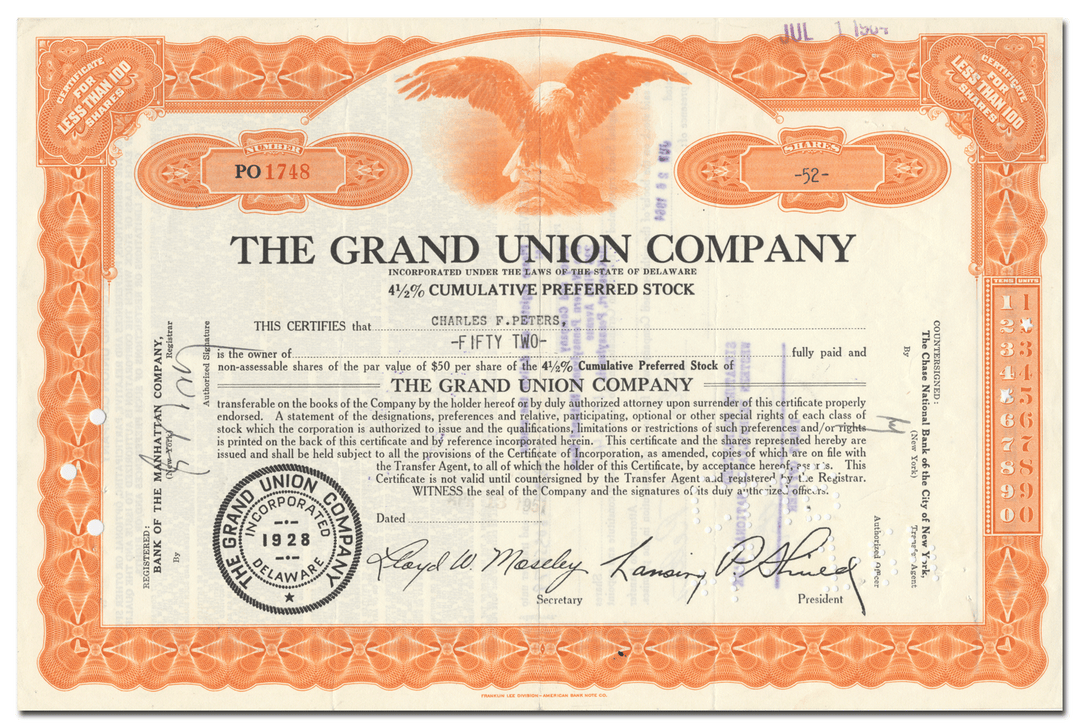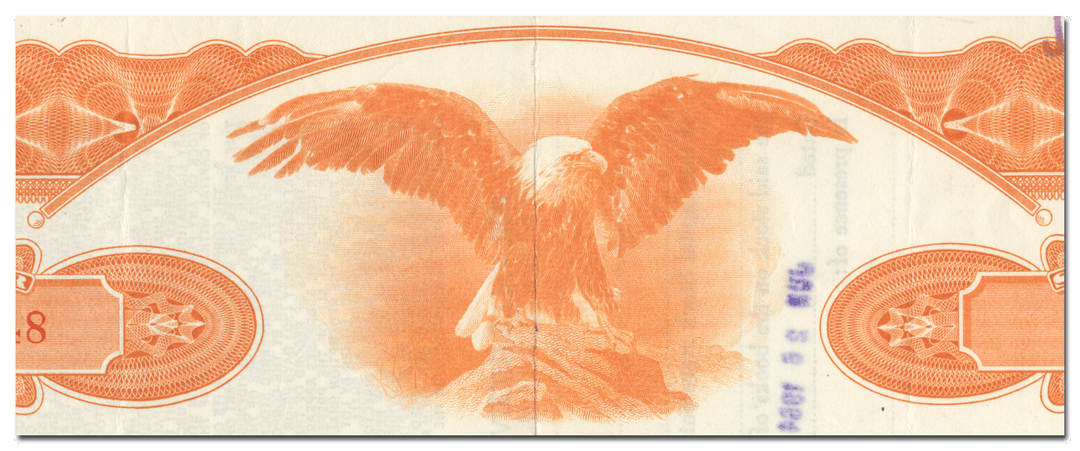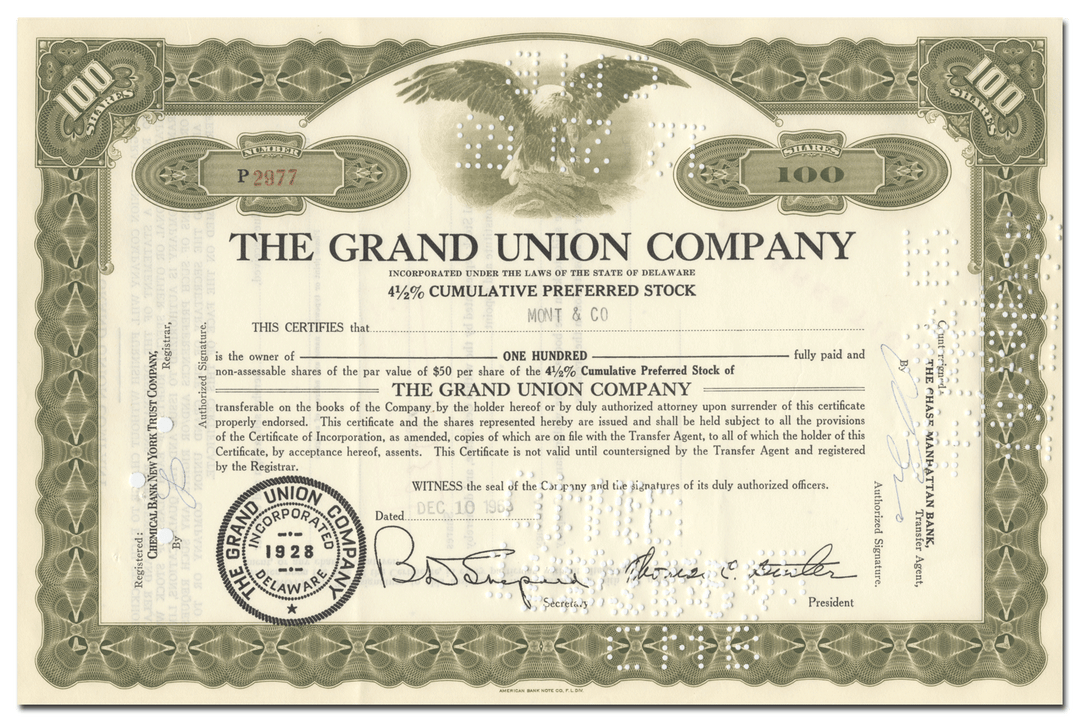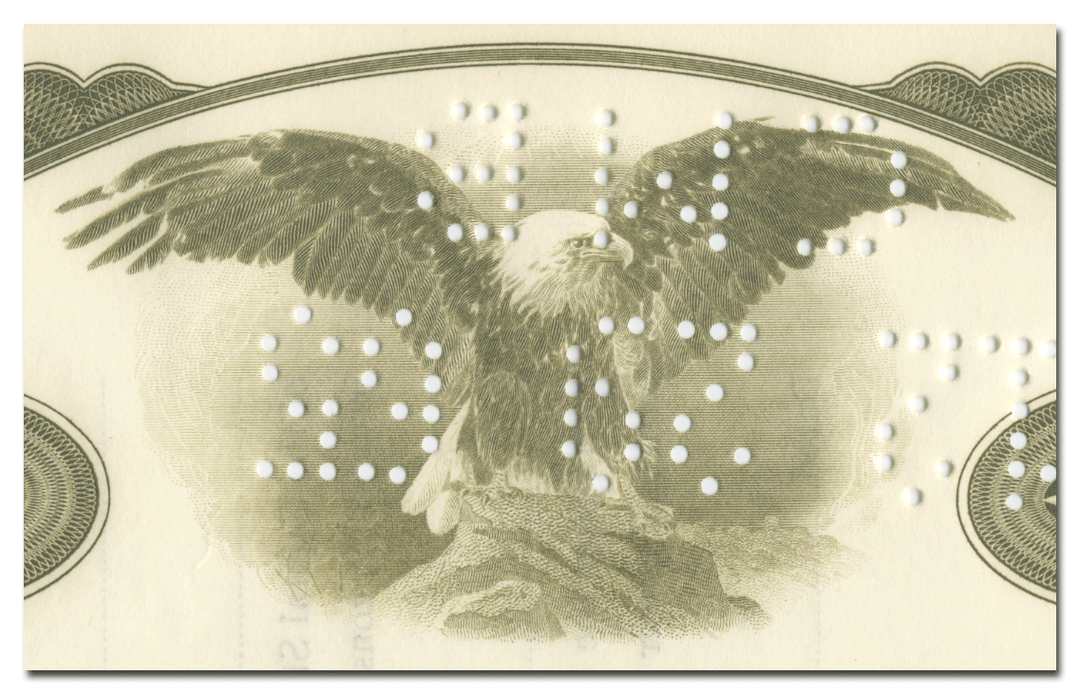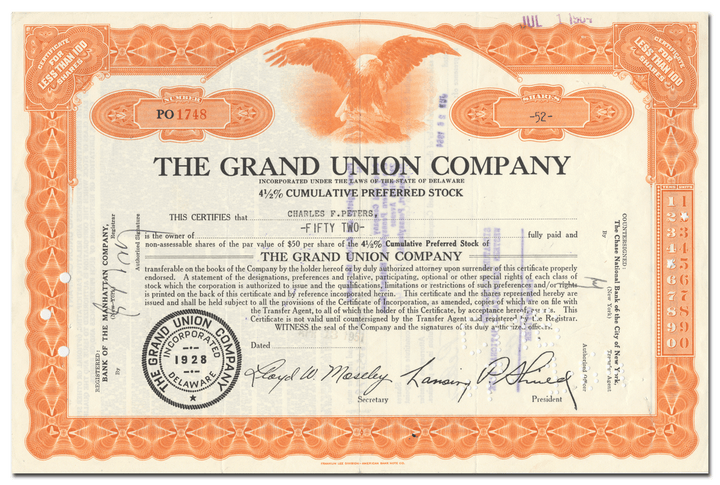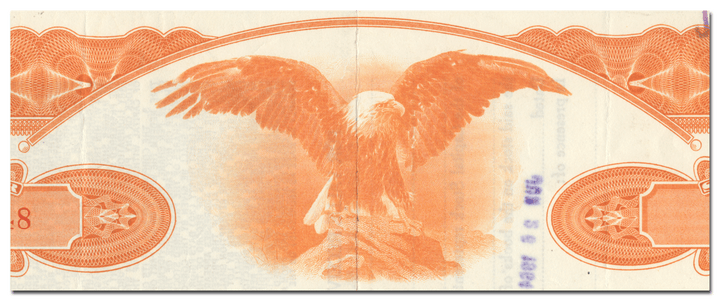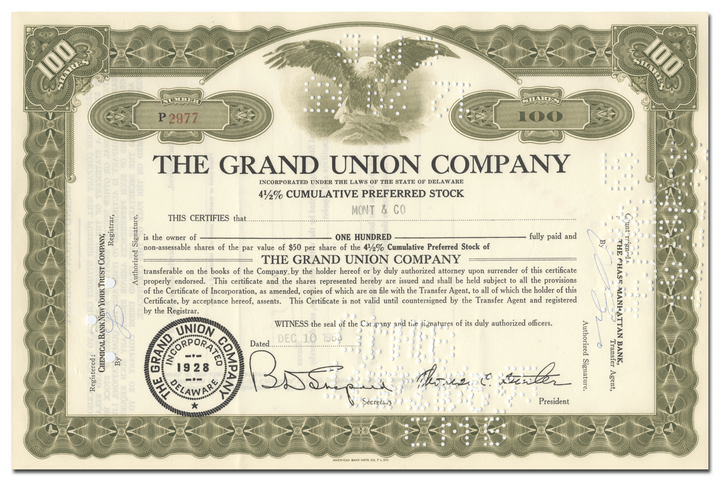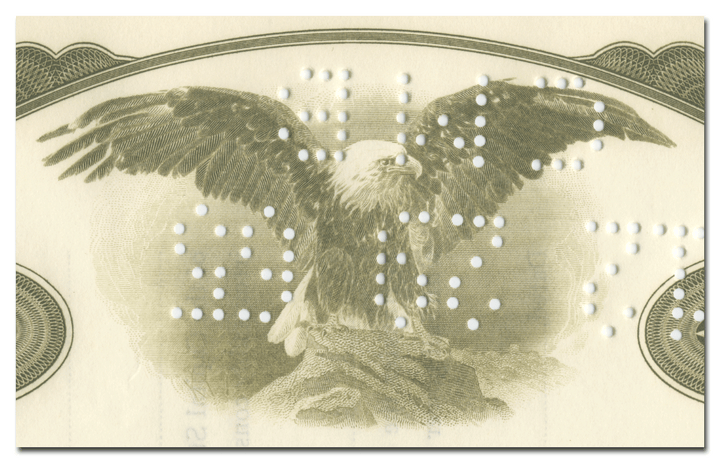Grand Union Company
- Guaranteed authentic document
- Orders over $75 ship FREE to U. S. addresses
Product Details




Certificate Type
Cumulative Preferred Stock
Date Issued
April 13, 1951 (orange)
December 10, 1965 (olive)
Canceled
Yes
Printer
American Bank Note Company (olive)
Franklin-Lee Division, American Bank Note Company (orange)
Signatures
Machine printed
Approximate Size
11 3/4" (w) by 7 3/4" (h)
Additional Details
NA
Historical Context

Grand Union started in Scranton, Pennsylvania as the Jones Brothers Tea Company in 1872. By the 1930s it was one of the largest grocery chains in the United States. The name "Grand Union" was inspired by the desire to "unite shoppers with low prices in a 'Grand Union of Value'" as described by company associate Elvin Sanders. The store's mascot was Abraham Lincoln wearing a deli apron, and most stores featured a costumed Lincoln to accomplish deeds, talk to customers, and proclaim the general splendor of the Grand Union, and to urge them to "Save the Union" when the company faced economic hardship.
In the early 1950s, Grand Union began construction on a new shopping center in what was then known as East Paterson (now Elmwood Park) New Jersey. The strip was to include a new Grand Union store with an office tower attached that would serve as the company's new corporate headquarters. The store and new headquarters opened in 1951. In 1987, Grand Union moved its corporate headquarters to Willowbrook Center in Wayne, abandoning its Elmwood Park offices. Grand Union did not close the Elmwood Park store, though, and it remained in operation until 2001.
In 1956, Grand Union opened a discount department store chain (called Grand Way) in Keansburg, New Jersey. Many of these stores combined a grocery store and a department store, which was similar to the combination Bradlees and Stop & Shop stores that were around during that time as well. Others were separate stores. For instance, a multi-level Grand Way store was built on a vacant lot across from the Elmwood Park corporate headquarters while the company built a strip mall in nearby Paramus, where the Grand Way anchored one end with the Grand Union anchoring the other. These stores were eventually closed and sold to other competitors, such as Winn-Dixie. The Elmwood Park and Paramus Grand Way stores were sold to Kmart; the Paramus store was liquidated and closed in December 2014 while the Elmwood Park store met that same fate in 2017.
In 1959, Grand Union's 38 stores it operated in Ontario, Canada, were sold to Steinberg's (supermarket), a Quebec-based supermarket and department store chain. Those locations were quickly rebranded into Steinberg's grocery stores, but over time most of their former Grand Union stores were closed and moved to new stores, due to poor locations compared to local competitors.
British corporate raider Sir James Goldsmith acquired Grand Union in the early 1970s. Grand Union was a money loser during much of Goldsmith's time of ownership. Goldsmith presided over the closing of the Grand Way chain in 1978 and the exit of Grand Union from most of the rest of the nation outside of the Northeast and New England in the mid-1980s.
In the 1980s Grand Union acquired many former A&P stores in northern New Jersey that A&P closed after acquiring the metropolitan New York operations of Stop & Shop and a controlling stake in the southern grocery chain Big Star Markets. In October 1986, Grand Union leased ten stores in the Albany area from Weis Markets, including nine stores that had operated under the Albany Public Markets banner. In the mid-1980s, Goldsmith brought in former Target Corporation executive Floyd Hall to manage the chain. Goldsmith also had world-renowned artist Milton Glaser complete a graphical redesign of the chain, which included the "red dot" theme. Through the new management under Hall, the chain was able to make record-making profits throughout the late 1980s. Goldsmith sold the chain to Floyd Hall and a group of investors in 1988. The chain, however, was quickly resold.
In 1989, investment banker Gary D. Hirsch, a partner in the firm Miller Tabak Hirsch & Co. acquired a portion of the Grand Union Company with Salomon Brothers. Grand Union was Hirsch's fourth major supermarket purchase since 1987, as he had acquired the Pennsylvania-based Penn Traffic, the Syracuse, New York-based P&C Foods, and the Columbus, Ohio-based Big Bear Stores in the previous two years. Hirsch assumed the position of chairman while Joseph McCaig became CEO. Floyd Hall left upon the acquisition.
Under Hirsch's leadership the company was driven into serious debt and ran out of the necessary capital for store improvements and upgrades, making it difficult for them to compete with other better financed retailers. Still, gradually, Grand Union remodeled most of its stores. Some of its older, run-down stores were closed and converted to other uses. Grand Union's big disadvantage was that its average store was 35,000 square feet while most supermarkets being built were over 50,000. The company also built a few larger stores.
In 1995, Grand Union's ongoing financial difficulties forced the company into its first bankruptcy as it filed for Chapter 11. In 1996, shortly after Grand Union emerged, Hirsch announced his resignation and sold his share of the company.
In 1997, Grand Union brought in J. Wayne Harris to begin a turnaround of the ailing chain. Harris had recently been an executive at A&P and at Kroger, and had an excellent reputation in the industry.
Harris immediately began remodeling stores and building larger ones, which put even more stress on the company's finances and forced another Chapter 11 filing in 1998. The company emerged again in 1999 and had $175 million in new capital, which Harris used to finish the remodels on the stores that were still in the process and to acquire more construction permits for larger stores. He also used some of the money for new store formats, with three emerging. One was "Grand Union Fresh Market", which catered more to an upscale gourmet clientele more in the vein of its competitor Kings. Another was a discount grocery store named "Mega Save". A third was Grand Union's answer to limited selection chains such as Aldi and Save-A-Lot, called "Hot Dot".
None of these ideas worked out, and again Grand Union's finances reached dire straits. In addition to this, many of Grand Union's executives were found to have been stealing money such as Don Vaillancourt, who was convicted of embezzling over $2 million from the company in 2002. Harris was forced out in 2000 and took a job with JCPenney, who hired him to revive their Eckerd drugstore chain. Harris failed to do that as well, and Eckerd was sold to a combination of Jean Coutu Group and CVS Corporation in 2004. Its stores were converted to the Rite Aid banner.
In addition to the now-critical debt being borne by Grand Union, the company was unable to build the stores it wanted to as there was not enough money left. A Fishkill, New York store was sold to a ShopRite ownership group before it could open, and the construction of a store in its home area of Wayne, New Jersey, was halted for over a year.
In October 2000, Grand Union filed for Chapter 11 bankruptcy for a third time. Two months later, the bankruptcy was converted to a Chapter 7 bankruptcy after it was discovered that the damage Harris' failed ideas and the embezzlement scandal had done to the company left it with so little money that Grand Union could not operate or supply any of its stores. A search for a buyer began, but in spite of the filing, the stores continued to do business as before.
Grand Union's Chapter 7 filing had a large effect on its supplier C&S Wholesale Grocers, a New England-based wholesale food distributor of which Grand Union was its largest customer. C&S also was one of Grand Union's largest creditors, and made a stalking horse offer to take control of the company in early 2001 that was approved.
Shortly afterward, C&S began reorganizing Grand Union's operations. This resulted in a consolidation that left the chain with only a relatively small number of stores in smaller cities and towns across Upstate New York and New England. In addition, Grand Union's stores in the Northeast - where it was long established - were closed. Many of the medium-sized and most of the larger Grand Union stores, as well as most of the construction permits for stores that had yet to be built or finished, were sold to Ahold while C&S continued to supply the stores. At the time of the acquisition of Grand Union by C&S, Ahold had been looking to establish a presence in the Northeast as well through its Edwards Super Food Stores chain and was initially a bidder for Grand Union. Eventually Ahold converted the Edwards stores to Stop & Shop, reintroducing the brand to the area, and later converted the Grand Union stores it acquired to Stop & Shops as well. Ahold began supplying Grand Union stores for some time prior to their rebranding. This meant that although the store retained the Grand Union sign on the outside and various other signage on the inside, it had Stop & Shop branded items on the shelves.
Other supermarket chains that purchased Grand Union stores included Tops, which was at the time also an Ahold subsidiary, Shaw's, Hannaford, Price Chopper and Pathmark. Some of the other medium-sized stores were sold to department store chains such as Marshalls and Kohl's, while many of the smaller stores were sold to independent grocers and drugstore chains such as Eckerd, Rite Aid, CVS, and Walgreens. Other stores, like the former flagship in Elmwood Park, were demolished after closing and replaced with other buildings.
As for the stores that remained under the Grand Union banner, they became part of a rebranded Grand Union Family Markets, complete with a new logo that discarded the 1980s "Red Dot" logo. Many of the stores did keep the Red Dot, although not all of them did.
On July 19, 2012, Tops Markets announced that it would acquire the 21 remaining Grand Union stores in the Adirondack Region and parts of Vermont. The terms of the deal were not disclosed. On May 28, 2013 grand reopening ceremonies were held for 9 stores which had been re-bannered under the Tops Friendly Markets name. The remaining 12 stores held grand reopening ceremonies on July 2, 2013 under the Tops Friendly Markets banner, effectively bringing an end to the Grand Union supermarket chain.
Related Collections
Additional Information
Certificates carry no value on any of today's financial indexes and no transfer of ownership is implied. All items offered are collectible in nature only. So, you can frame them, but you can't cash them in!
All of our pieces are original - we do not sell reproductions. If you ever find out that one of our pieces is not authentic, you may return it for a full refund of the purchase price and any associated shipping charges.






